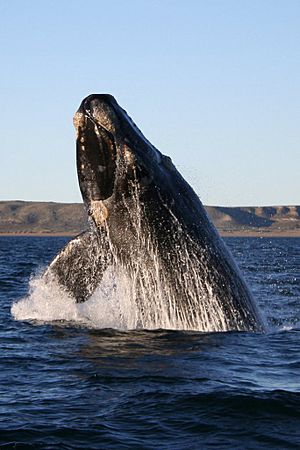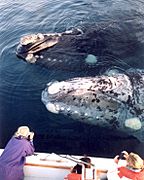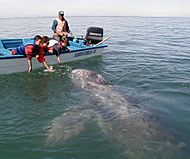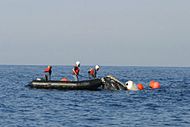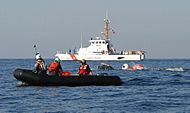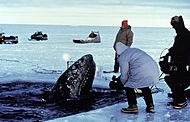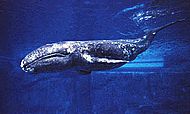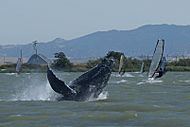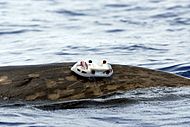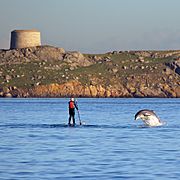Cetacean surfacing behaviour facts for kids
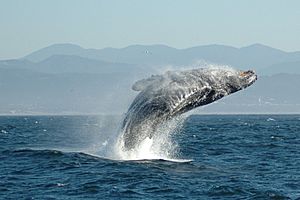
Cetacean surfacing behaviour is a grouping of movement types that cetaceans make at the water's surface in addition to breathing. Cetaceans have developed and use surface behaviours for many functions such as display, feeding and communication. All regularly observed members of the order Cetacea, including whales, dolphins and porpoises, show a range of surfacing behaviours.
Cetacea is usually split into two suborders, Odontoceti and Mysticeti, based on the presence of teeth or baleen plates in adults respectively. However, when considering behaviour, Cetacea can be split into whales (cetaceans more than 10 m long such as sperm and most baleen whales) and dolphins and porpoises (all Odontocetes less than 10 m long including orca) as many behaviours are correlated with size.
Although some behaviours such as spyhopping, logging and lobtailing occur in both groups, others such as bow riding or peduncle throws are exclusive to one or the other. It is these energetic behaviours that humans observe most frequently, which has resulted in a large amount of scientific literature on the subject and a popular tourism industry.
Dive times
Time intervals between surfacing can vary depending on the species, surfacing style or the purpose of the dive; some species have been known to dive for up to 85 minutes at a time when hunting, and dives in excess of three hours have been observed in Cuvier's beaked whale under extreme circumstances.
Human interaction
-
Humpback whale and kayakers off Avila Beach, California
-
Rescuing North Atlantic right whale from by-catching
-
"Dawn" in Sacramento River
-
Bottlenose dolphin and a paddler at Dalkey Island
Whale watching is carried out on every continent, with an estimated 13 million people participating in 2008. This, when combined with the sustained increase in boat vessel traffic, has likely affected the surface activity of cetaceans. When boats and other whale watching vessels approach, most cetaceans will either avoid or seek interactions. The occasions where no effect is seen is predominantly when the cetaceans are travelling or feeding, but not when they are showing surface activity. In the case of avoidance, the animals may dive rather than staying submerged near the surface or move horizontally away from the vessels. For example, when sperm whales are approached by boats they surface less, shorten the intervals between breathes and do not show their fluke before diving as often. Cetaceans may also reduce their acrobatic surfacing behaviours, such as when humpback whale groups without calves are approached by vessels to within 300 m. Avoidance behaviour is typical of whales, but interactions are more common in whale groups that contain calves and also in the smaller Odontocetes. For example, studies on killer whales in North America have shown that the focal animals increased their tail-slapping behaviour when approached by boats within 100 m, and that 70% of surface active behaviours (SABs) in these orca were seen when a boat was within 225 m. Similarly, dusky dolphins also jump, change direction and form tighter groups more when boats are present, particularly when they do not adhere to the regulations about approach. As an increase in SABs is beneficial to the whale watching tours’ participants, the tours may be encouraged to approach cetaceans closer than recommended by guidelines. There is a lack of understanding about the long-term effects of whale-watching on the behaviour of cetaceans, but it is theorised that it may cause avoidance of popular sites, or a decrease in the energy budget for individuals involved.
See also
- Beached whale
- Tail-walking


